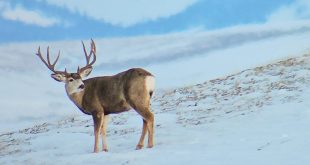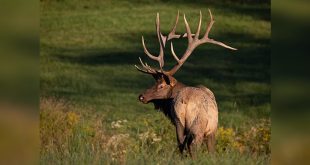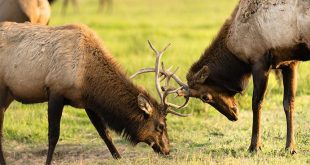
As I’ve said many a time, hunting antelope and hunting big antelope are two very different things. To find the biggest buck in your area, you are going to have to put in the time, cover tons of country, glass boatloads of bucks and be very patient and methodical in the process. Just finding antelope in your area is usually a relatively straightforward proposition but finding a really big buck, not so much. Glassing and covering massive amounts of country is the best technique to start off with. Locating and keeping tabs on the biggest buck in your area is where most of the challenge lies.

Pre-Scouting – The first order of business for me when scouting antelope is to get the lay of the land in general. This can be done a number of different ways and I usually find myself employing most if not an all of the above strategy my first time into an area.
The best place to start is the state hunting proclamations and Google Earth or the onX Hunt app. This gives me a good idea of what the area looks like from a satellite imagery and aerial photography perspective. Here I am looking at three criteria mostly. First off, I want to know where the boundaries for the area lie, are they roads, ridges or creek drainages? More on this later. The next area I am targeting and making note of are the water sources. Contrary to most conventional thinking, antelope are not camels. They need water and lots of it. A rutting buck needs to hit a water source at least once and sometimes even twice daily, about the same as a bull elk. For some perspective, a desert mule deer buck will water up only half as often. The third and final areas I am looking for are big sage flats or open country that are near water and contain some deeper brush and/or coulee cuts close by. For some reason, big rutting bucks always tend to find areas that have a few good places to hide out if necessary due to hunting pressure or pressure from competing bucks for a hot doe. After I have located and marked these areas of primary interest on my map or onXmap application, I am ready to head afield.
Covering Country – Once in country, I like to get an idea of what the unit looks like in person. For some weird reason, a piece of country never quite looks the same on the computer as it does in person. I want to explore the entire unit quickly and easily. This usually means, driving the borders of the unit or as much of it as possible. This gives me a good idea of what types of country and access I have available to hunt. A quick two or three-hour tour around the unit with my phone in hand, pushing me the public and private land access on my onXmap app and I can quickly get a good judge on the area and the access for the unit. This further narrows down my search for a big buck. It can be hard to explain in words, but once you do this enough, you will just get a feeling or a hunch of where the best places to start will be. Couple that with your online, at-home research and you should have a pretty solid game plan for the next morning’s hunt. I usually try to have between four and six areas to concentrate my efforts on initially. Most of the time these revolve around roads or road systems.
As I travel around the unit, I also find myself nearly beyond meticulous about noting large tracts of hard-to-access public land, water sources that have water in them at the time, and antelope densities. Some areas will just have higher antelope densities than other parts of the unit. There are some very specific tips and methods that can help you turn up a monster buck that most hunters will have a hard time finding. Here are a few of the specifics on those processes and methods.
Learn the Rut – Antelope have a very long rut, probably the longest of all the big game species in fact. The antelope rut begins around the first week of August in most areas and lasts clear up until the snow begins to fly in mid-October. Antelope bucks are very, very aggressive during the rut. A big mature buck will “scrape” off his territory about the final week of July just like a rutting whitetail buck would. This area is usually about 5-10 square miles in area, and always contains at least one good water source. In areas with very sparse water availability three or four bucks will use the same water source as the edge of their area. Think spokes on a wheel with the water source as the hub. This can make for some very interesting confrontations during the evening hours as two competing or neighboring bucks bring their does to water at the same time and a hard-core buck antelope fight can easily knock 3” or 4” off a buck’s score in a heartbeat as the dust and bits of horn fly into the wind.
Once you find a big buck, learn his area as much as you can before you plan a stalk. More than once, have I had to literally grid off a buck’s area and methodically search each and every square inch only to finally find him hunkered down in a hidden coulee or juniper patch hiding his does from any traveling bucks. Always, remember, a buck works and fights very hard for his area, and he will be extremely reluctant to leave it. If you can manage to find a giant rutting buck, keep on him. He is probably there somewhere or will return soon. Don’t give up on him. A big rutting buck will usually only leave his area under three circumstances – a hot doe, inclement weather (usually snow), or he is shot at or wounded.
As mentioned before, a buck antelope will need water. If you can’t find him, or he is in a bad spot for a stalk, hold tight and wait him out. Many a time, have I waited at or near a buck’s water source for hours waiting for him to break down and bring his does to water where I could get a shot. A buck antelope headed for water will have his guard down big time.
By the 20th of October with most of the rut behind them, the bucks’ areas begin to collapse, and the antelope start herding up together for the winter. This can be a great time to kill a huge buck, as you will often find gaggles of bucks running together. This is always the best time to hunt, for someone who finds judging a buck to be a challenge. If you shoot the biggest buck out of a group of 200 antelope, you have probably killed the biggest buck in a 20-mile radius. For most of us, it’s much easier to judge bucks when they are all standing together than trying to field judge them separately scattered all over the prairie.
By Halloween the bigger bucks will start popping their caps off. For some reason the bigger bucks always drop their horns first and will even employ the aid of fence lines to pull them off prematurely. For this reason, if you haven’t killed your buck by the 25th of October you might be in trouble.
Play the Sun – Always remember, low light is an antelope hunter’s friend. I usually try to do most of my core antelope hunting and stalking in low or soft light conditions. An antelope does have about a 10X eye and can see nearly 360 degrees at all times, giving him a large advantage in any stalking situation. The downside of this for the antelope is under low or soft light conditions, an antelope loses most, if not all, of his depth perception. A buck will have a hard time telling if you are 1000 or 100 yards away under these conditions. He will also have a much harder time detecting your movements even at relatively close distances, a huge advantage for the spot and stalk bowhunter. However, under midday harsh sunlight conditions, a buck and his does can be very, very hard to get close to.
For this reason, I usually center my spotting, stalking and judging in the mornings and evenings while I reserve the midday sun for covering country, exploring unknown areas of the unit and midday naps. More times than I can count, I have put a big buck to bed that was found midday, only to return to camp for a meal and nap and return to kill the buck right before dark or early the next morning. Midday scouting missions are also a good time to bank bucks for further scrutiny and a possible stalk during the right low-light conditions.
The low sun will also increase your efficiency at spotting antelope drastically. For this reason, I always plan my spotting routines to put the sun at my back. I usually work a piece of antelope country from east to west in the morning and from west to east in the evening. Antelope have a hard time looking into the sun just like humans do, so placing that sun at your back not only makes the antelope almost glow, it also gives you some concealment advantages as well. A buck that is nearly impossible to get within a 1,000-yards of can easily be walked right up to during very low, soft light conditions with the sun at your back.
CLICK HERE TO CHECK OUT GUY EASTMANS’ TOP 2020 ANTELOPE UNITS!
It’s very important to keep in mind, that antelope are very difficult to find under cloudy and stormy conditions. A very meticulous glassing method will be needed to find the antelope in your areas under these conditions. The best way to handle this is to get on a high point with your spotting scope and spend at least an hour there glassing every nook and cranny of the landscape.
Find the Sweet Spots – For some strange reason, more than any other big game animal I’ve ever hunted big antelope tend to come from the same areas or regions. Both Mike and I have killed multiple Boone and Crockett bucks within a mile of each other four or five years apart. For some reason, certain areas just tend to produce big bucks. I think it has to do with feed and genetics. Due to the way antelope bucks rut, the same does are getting bred by the same bucks, year after year causing almost clones of bucks to be produced in very close proximity to each other. This causes a certain flat or drainage to simply produce big bucks, particularly on a good year. Once you find these sweet spots or honey holes, I always check them first once I have a tag in pocket. These will be your best shot at a monster buck if there is one to be had.
Case in point, Mike has killed three B&C all-time antelope bucks all within three miles of each other over a 15-year span in his favorite Wyoming public land antelope area. This is a very high concentration of monster bucks inside a hunt area that is nearly 600 square miles. Antelope hunting is getting ever more popular. Finding a big buck is no easy task, but a true antelope trophy hunt is about as exciting and as fun as it gets. By hunting your antelope area as much as possible you can not only refine your techniques but also get to know your area inside and out, and that is what will put more big bucks on the ground for you in the future.
 Eastmans' Official Blog | Mule Deer, Antelope, Elk Hunting and Bowhunting Magazine | Eastmans' Hunting Journals
Eastmans' Official Blog | Mule Deer, Antelope, Elk Hunting and Bowhunting Magazine | Eastmans' Hunting Journals






One comment
Pingback: Scouting for Big Pronghorn - Eastmans' Official Blog | Mule Deer, Antelope, Elk Hunting and Bowhunting Magazine - Florida News